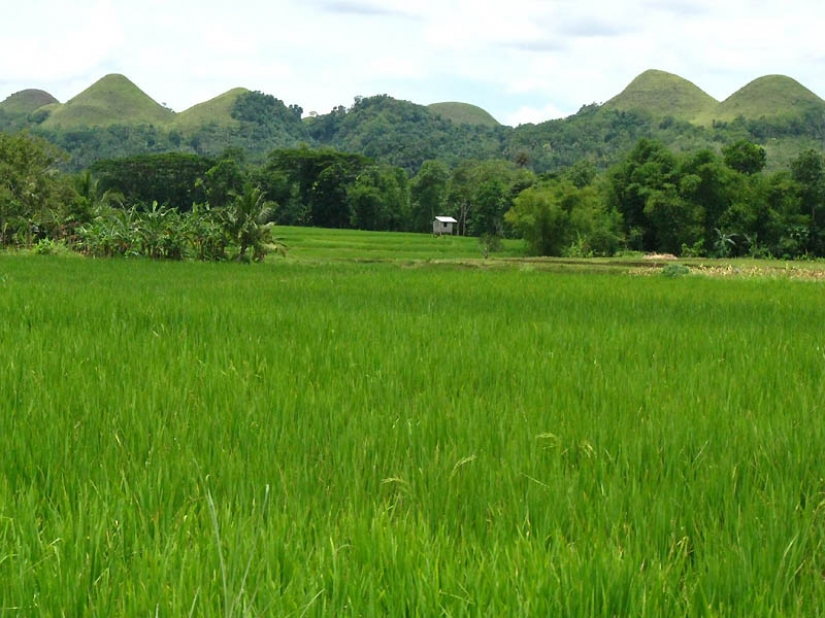Chocolate Hills of Bohol Island
Categories: Nature
By Pictolic https://pictolic.com/article/chocolate-hills-of-bohol-island1.htmlThe island of Bohol in the Philippines is the birthplace of a very unusual geographical landscape - Chocolate Hills. No, this is not a set for the movie "Charlie and the Chocolate Factory", this is a very real place on our amazing planet Earth. In summer, the dense vegetation covering the hills turns brown, which is why the hills are called Chocolate.


Strangely, no one has ever found out the exact number of these strange hills. But it is believed that about 1800 dot the central part of the island of Bohol. And yet, what gives these hills their cone-shaped shape? Maybe these are ancient, man-made burial grounds?

Although these symmetrical hills are surrounded by many myths (which is not surprising), in fact it is a product of a natural process, and not the work of human hands. The hills are made of limestone, which then covered the vegetative soil on which the grass grew.

These are not just hills on earth. The largest of them rises almost 121 meters above the Bohol plain, although their average height is about 30-48 meters.

These amazing hills have become the main source of tourism income for the nearby town of Carmen.

In the dry season, when there is not a drop of rain, the grass on the hills dries up (but does not die), and the hills acquire their chocolate color.

Limestone on the hills is called karst. This landscape appears when the bedrock layers are created from a soluble substance such as dolomite or, in this case, limestone.

They say that the hills got their name from the sweets of the confectionery factory "Hershey", which are called Chocolate kisses, but this is not yet a fact. If Hershey candies appeared in 1907, then the hills appeared much earlier.

The landscape was slowly changing in a process known as solvation. And the hills are what's left of this process.

The shape of the hills, known as the geomorphological structure, is called mogote. Although the hills were formed by the solvation of limestone under the millennial effects of rain, there is another factor.

Their formation was also affected by the erosion of rivers that rose above sea level. The agricultural area separating the hills is full of rivers and caves with underground springs, and all of them have contributed to the unique shape of the Chocolate Hills.

But, of course, as is the case with any unusual geographical place, the hills are shrouded in legends.

According to one of them, two giants once quarreled. They fought, throwing huge stones at each other until they were exhausted. When they woke up, they forgot about their quarrel and dispersed, but did not even bother to clean up after themselves.

If you are a romantic nature, then you will like the legend of Arogo and Aloya more. Arogo was a giant, but Aloya was a mortal, and her life was shorter. When Aloya died, Arogo cried so hard that when giant tears fell to the ground, Chocolate Hills grew in their place.

According to other legends, the hills arose here by the whim of some giant who wanted to lose weight, or a huge moose with an inverted belly. If these legends had taken root, the Chocolate Hills could have received a completely different name.

The hills were declared a national geographic monument in 1988, but mining continued to reduce the number of hills until 2006.

Even though this place has received the status of a UNESCO World Heritage Site, local residents continue to dig quarries here.
Keywords: Landscape | Island | Landscapes | Philippines | Chocolate
Post News ArticleRecent articles

Parenting looks flawless and attractive only in advertising diapers or on posters in a women's clinic. Experienced parents know ...

I want to somehow distract myself from the news about the pandemic and plunge into the beautiful. Here, for example, is a story ...
Related articles

There are on our planet, these places, which can only stand and watch, open-mouthed. Because they look really exciting. See a ...

Hans Gunnar Aslaksen is a 49-year-old landscape photographer from the small town of Lavrik on the southern coast of Norway. A happy ...

These photos are real. No Photoshop. No modifications, retouching and graphics. These are real pictures of real objects. Something ...

There is something hard to explain that draws us to old photos. Oddly enough, this effect also works with new, retro-styled photos. ...